How to Cite | Publication History | PlumX Article Matrix
Y. Neeraja et al
1Centre for Biotechnology, University College of Technology,
2Department of Microbiology, University College of Science, Osmania University, Hyderabad India.
Corresponding Author E-mail: mnreddydr@gmail.com
ABSTRACT: Fermentation process for the production of itaconic acid was carried out using Aspergillus terreus NCIM657 from cornstarch as a carbon source was investigated. Itaconic acid is commercially produced by the cultivation of Aspergillus terreus NCIM657 with molasses .Cornstarch is one of the best carbon source among various carbohydrates, because it is inexpensive and easily available in market. The production medium consisted only of cornstarch pretreated by nitric acid at pH 2.5 before autoclaving at 121°C for 20 min .The production was carried out at various Temperature (28°C), pH (2.5), Inoculum level (3 ml), Substrate concentration (1.5gm), Incubation time(5 days).The sample were collected at 24hrs time interval. Itaconic acid concentration was measured by UV spectrophotometric method. Cornstarch shows maximum yield of 48.4g/l after 120hrs.
KEYWORDS: Submerged fermentation; Aspergillus terreus (NCIM657); cornstarch; itaconic acid
Download this article as:| Copy the following to cite this article: Neeraja et al Y. Effect of Different Cultural Conditions on Production of Itaconic Acid N by Aspergillus Terreus Using Submerged Fermentation. Biosci Biotechnol Res Asia 2009;6(1) |
| Copy the following to cite this URL: Neeraja et al Y. Effect of Different Cultural Conditions on Production of Itaconic Acid N by Aspergillus Terreus Using Submerged Fermentation. Biosci Biotechnol Res Asia 2009;6(1). Available from: https://www.biotech-asia.org/?p=8158 |
Introduction
Itaconic acid was discovered by Baup (1837) as a thermal decomposition product of citric acid. This a-substituted acrylic acid received this name by the rearrangement of aconitic acid, from which itaconic acid is formed by decarboxylation. Itaconic acid was originally known as a product of pyrolytic distillation of citric acid. Itaconic acid is an unsaturated dicarboxylic acid with many commercial uses. Unsaturated carboxylic acids have found wide spread of commercial uses especially in the field of plastics and resins. The biosynthesis by fungi from carbohydrates was first reported by Kinoshita (1932), who isolated itaconic acid from the growth medium of an osmophilic fungus, Aspergillus itaconicus.
Itaconic acid was first reported as a product of mold metabolism by Kinoshita in 1929, who obtained it from cultures of Aspergillus itaconicus, which he isolated from the juice of salted plums. This green species grows well only on media of high osmotic pressures such as concentrated sugar solutions and produces itaconic acid on media containing KNO3 as nitrogen source and 25%sucrose. Calam, Oxford and Raistrick(1939) reported obtaining small quantities of itaconic acid from a strain of Aspergillus terreus NCIM657 and preliminary investigations conducted by Moyer and Coghill(1945) confirmed the suitability of Aspergillus terreus NCIM657 for bringing about this reaction. Lockwood and Reeves (1945) screened over 300 strains of Aspergillus terreus NCIM657and found eleven that were efficient producers of itaconic acid from glucose.
An efficient process for the production of itaconic acid has been stated as the fermentation of carbohydrate. The various carbon source used are molasses, glucose, sucrose, and cornstarch. Itaconic acid is commercially produced by the cultivation of Aspergillus terreus NCIM657 with molasses. Although the cost of molasses is low compared with other kinds of carbohydrates, the cost of itaconic acid production from molasses, including that of downstream processing and waste-treatment, is still high because the molasses contains many impurities which cannot be utilized by micro organisms. Therefore another cheaper raw material is required and Cornstarch is one of the best carbon sources among various carbohydrates, because it is pure, inexpensive and stable in a mass supply.
Materials and Methods
Chemicals
All chemicals and medium constituents used for the present study were procured from M/s Hi-media, Bombay (India).
Microorganism
Aspergillus terreus NCIM657 obtained from National chemical Laboratory (NCL), Pune, and was maintained on Potato Dextrose Agar (PDA) slants at 4-60C. Then it is subcultured once in a month. Spores were harvested from an 8 day old PDA slant in 5 ml of sterile distilled water.
Culture medium
Pre-culture medium
3.9 gm of Potato Dextrose Broth (PDB) was mixed in 100 ml of distilled water. The pH 2.5 was adjusted by using nitric acid at room temperature. Sterilization was done at 1210C pressure of 15 psi for 20 min in an autoclave.
Production medium
The production medium consists of 1.5gm of cornstarch, (D.Muralidhara Rao et al., 2007, Bressler and Braun, 2000), MgSO4– 0.025gm, K2HPO4-0.025gm, FeSO4-0.005 gm in 100 ml Distilled water. The pH 2.5 of the medium was adjusted using nitric acid at room temperature. This medium sterilized in an autoclave at 1210C 15 psi for 20 min (Xu et al., 1989; Nubel and Rakajak, 1964). After sterilization Aspergillus terreus NCIM 657 was inoculated to the production medium and incubated in Digital orbital shaking incubator (Lab-Tech3016R). The sample was collected at an interval of 24 hrs (walinky, 1984). The collected samples were used for the determination of itaconic acid, protein and glucose consumed was estimated.
Effect of pH
The effect of pH was studied by adjusting the pH ranged from 1.0 to 4.0 of fermentation medium. The pH of the medium was adjusted by using nitric acid. After inoculating 3ml of spore solution of Aspergillus terreus NCIM657, the flasks were kept in Digital Orbital shaking incubator (Lab Tech LSI-3016R) at 280C at 120 rpm. The samples were collected at an interval of 24hrs, and were used for the analysis of itaconic acid.
Effect of temperature
Effect of temperature was determined by incubating fermentation medium at 250C to 300C in Digital orbital shaking incubator (Lab Tech LSI-3016R) at 120 rpm. The samples were collected at an interval of 24hrs, and itaconic acid analysis was performed.
Effect of inoculum level
Inoculum level was determined by incubating fermentation medium with 1 ml to 5 ml of spore solution of Aspergillus terreus NCIM657. After inoculation the flasks were incubated in Digital orbital shaking incubator (Lab Tech LSI-3016R) at 120 rpm. The samples were collected at an interval of 24hrs, and the collected samples were used for the analysis of itaconic acid.
Effect of substrate concentration
For optimization of substrate concentration the cornstarch used in different concentrations from 0.25gm to 2.5gm. After inoculation the flasks were incubated in Digital orbital shaking incubator (Lab Tech LSI-3016R) at 120 rpm. The samples were collected at an interval of 24hrs, and the collected samples were centrifuged (REMI C-24) at 2000rpm for 20 min, the supernatant was collected and itaconic acid analysis was performed.
Effect of Incubation time
Effect of incubation time was determined by incubating fermentation medium for 1 to 7 days in Digital orbital shaking incubator (Lab Tech LSI-3016R) at 120 rpm. The samples were collected at an interval of 24hrs, and itaconic acid assay was performed by using collected samples.
Itaconic acid assay
Itaconic acid estimation was done by taking 1 ml of sample , add 1.3 ml of pyridine.And add 5.7 ml of acetic anhydride, allow it to cool at room temperature Finally add 2 ml of distilled water. Read the optical density at 385 nm by UV-Spectrophotometer (ShimadzuUV-160A).
Glucose estimation
Glucose estimation was done by the method DNSA (Dinitro salicylic acid) (Miller, 1959). Take 1 ml of sample, add 3 ml of DNSA reagent. Then add 1 ml of distilled water. Boil at 900 C for 15 min. Finally add 5 ml of distilled water. Read the optical density at 540 nm by UV-Spectrophotometer (ShimadzuUV-160A).
Protein estimation
The protein was measured in the culture supernatant, and estimated by modified Lowry’s method (1951).
Results and Discussion
Effect of pH on itaconic acid Production
The Aspergillus terreus NCIM657 was selected for the production of itaconic acid in submerged fermentation, the Aspergillus terreus NCIM657 produced itaconic acid over the entire range of pH (1.0 – 4.0). However, maximum itaconic acid production was observed at pH 2.5, and the itaconic acid production was about 1.443mg/ml (Fig.1).
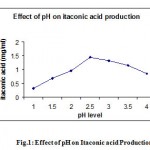 |
Figure 1: Effect of pH on Itaconic acid Production.
|
Effect of Temperature on Itaconic acid Production
Based on the exhibited itaconic acid activity and growth temperature range of 25 – 300C, and the effect of temperature on itaconic acid production was determined. The Aspergillus terreus NCIM 657 exhibited maximum itaconic acid activity at 280C, and the itaconic acid production was about 1.466mg/ml (Fig.2).
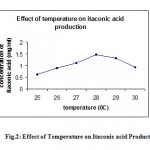 |
Figure 2: Effect of Temperature on Itaconic acid Production.
|
Effect of Inoculum level on Itaconic acid Production
The results in Fig.3 showed the effect of inoculum level on itaconic acid production. The flasks were inoculated with 1ml to 5ml of spore solution, where the maximum itaconic acid production was observed at 3 ml inoculum level, and the itaconic acid activity was about 1.498mg/ml (Fig. 3).
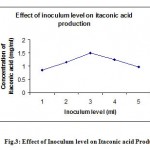 |
Figure 3: Effect of Inoculum level on Itaconic acid Production.
|
Effect of substrate concentration on Itaconic acid Production
Among the substrate concentrations maximum itaconic acid production was observed at 1.5gm and the itaconic acid activity was about1.548 mg/ml. (Fig.4)
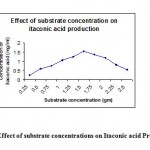 |
Figure 4: Effect of substrate concentrations on Itaconic acid Production.
|
Effect of incubation time on Itaconic acid Production
The effect of incubation time on itaconic acid production was determined for 1-7 days. The Aspergillus terreus NCIM 657 exhibited maximum itaconic acid activity at 5th day, and the itaconic acid production was about 1.548mg/ml (Fig.5).
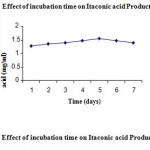 |
Figure 5: Effect of incubation time on Itaconic acid Production.
|
Acknowledgements
The author wish to thank Dr.Bharathi. Kodali and research scholars R. Sharada, J.Swarnalatha, & M.Anamika at Centre for Biotechnology, University College of Technology, Osmania University, Hyderabad, for their friendly co-operation.
References
- Baup S, Ueber eine neue Pyrogen-Citronensäure und überBenennung der Pyrogen-Säuren überhaupt; Ann. Chim. Phys.19: 29–38. (1837).
- Bressler E, Braun S Conversion of citric acid to itaconic acid in novel liquid membrane bioreactor. J. Chem. Technol. Biotechnol 75:66–72. (2000).
- Kinoshita K, Uber die Production von Itaconsaure and Mannit durch einen neuen Schimmelpiz Aspergillus itacnicus. Acta Phytochim. 5: 271-287. (1932).
- Lockwood LB, Reeves MD Some factors affecting the production of itaconic acid by Aspergillus terrus. Arch. Biochem. 6: 455-469. (1945).
- Nubel RC, Rakajak ED, US – Patent 3 044 941 (to pfizer): Process for production itaconic acid. (1964).
- Walinky SW, US – Patent 4 485 223 (to Pfizer): (Meth) acrylic acid/ itaconic acid biosynthesis by Aspergillus terreus . (1984).
- Lowry, O.H., Rosebrought, J., Farr, A.L. and Randall, R.J.,J.Biol.Chem.,193, 265. (1951).
- Xu DB, Madrid CP, Rohr M, Kubicek CP, The influence of type of concentration of the carbon source on production of citric acid by Aspergillus niger . Appl. Microbial. Biotechnol . 30: 553-558. (1989).
- Miller,G.L. use of Dinitrosalycilic acid reagent for determination of reducing sugars. Analytical chemistry.31, 426-430. (1959).
- D.Muralidhara Rao et al., Fermentative production of itaconic acid by Aspergillus terreus using jatropha seed cake, African Journal of Biotechnology Vol.6, 2140-2142, (2007).
- Calam CT, Oxford AE, Raistrick H, Production of Itaconic Acid with Immobilized Aspergillus terreus.J.Applied Microbiology and Biotechnology (1939).
- AJ Moyer, RD Coghill , The Laborator-Scale Production of Itaconic Acid by Aspergillus terreus Arch. Biochem, (1945).

This work is licensed under a Creative Commons Attribution 4.0 International License.





